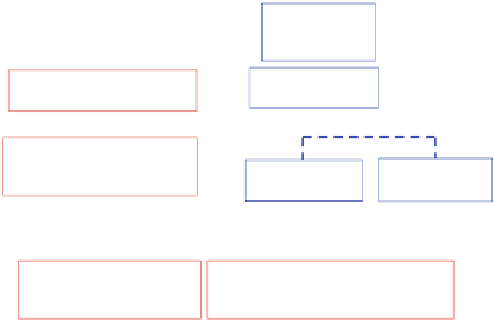Environmental Engineering Reference
In-Depth Information
Integration of emerging bio-geo-technologies
for reclamation of mine waste
A.Natural Attenuation
B. Biotechnologies
C. Geotechnologies
7.Bentonite and
Zeolites
1. Grass-Legume and Tree
association (Phytotechnology)
8.Backfiling
9.Organic
substrates and
biosolids
11.Geomembrane
and Geotextiles
10.Fly ash
2.Engineered vegetative caps
3. Ornamental cultivation -
suggested novel land use
12.Hydrogel
4. Soil-Plant-Rhizosphere
integration (rhizo-and myco
remediation)
13.Geopolymeric
binder
14. Transformed
Red mud
5. Biochar, charcoal as
carrier for microbial
remediation
6. Signal transduction enzyme
inhibition assays to isolate bioactive
secondary metabolites
F i g . 7
Integration of emerging biogeotechnologies for rec-
lamation of mine waste (
A
) Natural attenuation (Arienzo
et al.
2004
; Asensio et al.
2013a
,
b
; Bell
2001
; Bidar et al.
2007
; Bech et al.
2012
; Bradshaw
1997
; Chiu et al.
2006
;
Drahota et al.
2012
; Valente et al.
2012
) (
B
) Biotechnologies
1
- Grass-based phytomanagement (Pang et al.
2003
;
Tamang et al.
2008
),
2
- Engineered vegetative caps (Kim
and Benson
2004
),
3
- Ornamental cultivation - suggested
novel land use (Chintakovid et al.
2008
),
4
- Soil-plant-
rhizosphere continuum (Fitz and Wenzel
2002
; Solís-
Domínguez et al.
2011
),
5
- Biochar (Bian et al.
2013
;
Ahmad et al.
2014
),
6
- Use of signal transduction enzyme
inhibition assays to isolate bioactive secondary metabolites
acid mine waste lake (Stierle and Stierle
2013
), (
C
)
Geotechnologies
7
- Zeolite (Fall et al.
2009
),
8
-
Backfi lling (Benzaazoua et al.
2008
),
9
- Organic sub-
strates (Dobran and Zagury
2005
; Kijjanapanich et al.
2014
; Macías et al.
2012
; Santibáñez et al.
2007
,
2008
;
Zornoza 2012;
10
- Fly ash (Ram and Masto
2010
; Zhang
et al.
2011
),
11
- Geomembranes and geotextiles (Lupo and
Morrison
2007
),
12
- Hydrogel (Bigot et al.
2013
),
13
-
Geopolymeric binder (Pacheco-Torgal et al.
2008
),
14
-
Transformed red mud (Ardau et al.
2013
; Cappai et al.
2012
) and Red Clay (Mopoung and Thavornyutikarn
2006
)
harvested biomass (fronds only) will be 800 g/m
2
,
which will contain a total of approximately 4 g of
As. The reduction in soil As concentrations might
be in the order of 2 % per year in the example
quoted (Francesconi et al.
2002
). The As-rich
plant will itself need to be dealt with. The type of
inorganic arsenic compounds [arsenate, As(V)
and arsenite, As(III)] is present in the fern. The
As(III) was a predominant form in excised aerial
tissues, whereas the As(V) was the main form in
excised roots clearly demonstrated that As reduc-
tion occurred mostly in the fronds mainly in the
pinnae (Tu et al.
2004
). Combustion of such a
waste product is not a feasible option because it
would likely lead to release of toxic As
2
O
3
.
Disposal of the high As in fern biomass directly
into the open sea where it would degrade
(contribution marginally to nutrient levels) and
release inorganic As which could be converted to
a nontoxic form of arsenobetaine by natural pro-
cesses might be a feasible option (Francesconi
et al.
2002
).
Considering the needs of the local people, an
important criterion for selection of the potential
plants for phytoremediation could be provision
of economic benefi ts to the remediations, and
nonedible.
P. calomelanos
has the ability to
accumulate As; however, this fern is edible in
Thailand (Francesconi et al.
2002
). Therefore, the
use of ornamentals for, e.g., marigold, a triploid



















Search WWH ::

Custom Search